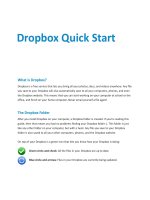s7300 sm331 ai 8x12 bit getting started en US en US
Bạn đang xem bản rút gọn của tài liệu. Xem và tải ngay bản đầy đủ của tài liệu tại đây (2.29 MB, 76 trang )
Preface
SIMATIC S7-300 SM331; AI 8x12 Bit Getting Started part 1: 4 -20mA
SIMATIC
S7-300
SM331; AI 8x12 Bit Getting Started
part 1: 4 -20mA
Getting Started
1
______________
2
Requirements
______________
3
Introduction
______________
Mechanical setup of the
example station
4
______________
5
Electrical connection
______________
Configuration of the
SIMATIC Manager
6
______________
7
Testing the user program
______________
8
Diagnostic interrupt
______________
9
Hardware interrupt
______________
A
Appendix
______________
05/2008
A5E00253410-04
Legal information
Legal information
Warning notice system
This manual contains notices you have to observe in order to ensure your personal safety, as well as to prevent
damage to property. The notices referring to your personal safety are highlighted in the manual by a safety alert
symbol, notices referring only to property damage have no safety alert symbol. These notices shown below are
graded according to the degree of danger.
DANGER
indicates that death or severe personal injury will result if proper precautions are not taken.
WARNING
indicates that death or severe personal injury may result if proper precautions are not taken.
CAUTION
with a safety alert symbol, indicates that minor personal injury can result if proper precautions are not taken.
CAUTION
without a safety alert symbol, indicates that property damage can result if proper precautions are not taken.
NOTICE
indicates that an unintended result or situation can occur if the corresponding information is not taken into
account.
If more than one degree of danger is present, the warning notice representing the highest degree of danger will
be used. A notice warning of injury to persons with a safety alert symbol may also include a warning relating to
property damage.
Qualified Personnel
The device/system may only be set up and used in conjunction with this documentation. Commissioning and
operation of a device/system may only be performed by qualified personnel. Within the context of the safety notes
in this documentation qualified persons are defined as persons who are authorized to commission, ground and
label devices, systems and circuits in accordance with established safety practices and standards.
Proper use of Siemens products
Note the following:
WARNING
Siemens products may only be used for the applications described in the catalog and in the relevant technical
documentation. If products and components from other manufacturers are used, these must be recommended
or approved by Siemens. Proper transport, storage, installation, assembly, commissioning, operation and
maintenance are required to ensure that the products operate safely and without any problems. The permissible
ambient conditions must be adhered to. The information in the relevant documentation must be observed.
Trademarks
All names identified by ® are registered trademarks of the Siemens AG. The remaining trademarks in this
publication may be trademarks whose use by third parties for their own purposes could violate the rights of the
owner.
Disclaimer of Liability
We have reviewed the contents of this publication to ensure consistency with the hardware and software
described. Since variance cannot be precluded entirely, we cannot guarantee full consistency. However, the
information in this publication is reviewed regularly and any necessary corrections are included in subsequent
editions.
Siemens AG
Industry Sector
Postfach 48 48
90026 NÜRNBERG
GERMANY
A5E00253410-04
Ⓟ 08/2008
Copyright © Siemens AG 2008.
Technical data subject to change
Table of contents
1
Preface ...................................................................................................................................................... 5
1.1
2
Requirements ............................................................................................................................................ 7
2.1
3
Basics.............................................................................................................................................7
Introduction................................................................................................................................................ 9
3.1
4
General ..........................................................................................................................................5
Example of an application..............................................................................................................9
Mechanical setup of the example station ................................................................................................. 11
4.1
4.2
4.2.1
4.2.2
4.2.3
4.2.4
4.2.5
5
Mounting the example station ......................................................................................................11
Mounting of analog module components.....................................................................................13
General ........................................................................................................................................13
Components of the SM331 ..........................................................................................................14
Features of the analog modules ..................................................................................................15
Measuring range modules ...........................................................................................................16
Mounting the SM331 module .......................................................................................................18
Electrical connection................................................................................................................................ 19
5.1
5.2
Wiring the power supply module and the CPU ............................................................................20
5.3
5.3.1
5.3.2
5.3.3
5.3.4
6
Overview ......................................................................................................................................19
Wiring of the analog module ........................................................................................................22
Requirement.................................................................................................................................22
Current transducer wiring - principle............................................................................................22
Wiring of the analog module ........................................................................................................23
Test ..............................................................................................................................................26
Configuration of the SIMATIC Manager ................................................................................................... 27
6.1
6.1.1
6.1.2
6.1.3
6.1.4
6.1.5
Creating a new STEP7 project.....................................................................................................27
Creating a new project .................................................................................................................27
CPU selection ..............................................................................................................................29
Defining the basic user program ..................................................................................................30
Assigning the project name..........................................................................................................31
Result S7 project is created .........................................................................................................32
6.2
6.2.1
6.2.2
6.2.3
6.2.4
Hardware configuration................................................................................................................33
Creating the hardware configuration............................................................................................33
Adding SIMATIC components......................................................................................................34
Configuring the analog module ....................................................................................................36
Test ..............................................................................................................................................39
6.3
6.3.1
6.3.2
STEP 7 user program ..................................................................................................................43
Tasks of the user program ...........................................................................................................43
Creating a user program ..............................................................................................................44
SM331; AI 8x12 Bit Getting Started part 1: 4 -20mA
Getting Started, 05/2008, A5E00253410-04
3
Table of contents
7
Testing the user program......................................................................................................................... 51
7.1
7.2
Visualization of the sensor values............................................................................................... 53
7.3
8
Downloading system data and user program ............................................................................. 51
Analog value representation ....................................................................................................... 57
Diagnostic interrupt.................................................................................................................................. 59
8.1
8.2
General diagnostics .................................................................................................................... 61
8.3
8.3.1
8.3.2
8.3.3
8.3.4
8.3.5
8.3.6
9
Reading diagnostic information from a PG ................................................................................. 59
Channel dependent diagnostic interrupts ................................................................................... 62
There are five channel dependent diagnostic interrupts............................................................. 62
Configuration / programming error.............................................................................................. 62
Common mode error ................................................................................................................... 62
Wire break ................................................................................................................................... 63
Underflow .................................................................................................................................... 63
Overflow ...................................................................................................................................... 64
Hardware interrupt ................................................................................................................................... 65
9.1
A
Hardware interrupt ...................................................................................................................... 65
Appendix.................................................................................................................................................. 67
A.1
Source of the user program ........................................................................................................ 67
Index........................................................................................................................................................ 73
4
SM331; AI 8x12 Bit Getting Started part 1: 4 -20mA
Getting Started, 05/2008, A5E00253410-04
1
Preface
1.1
General
Purpose of the Getting Started
The Getting Started gives you a complete overview of the commissioning of the analog
module SM331. It assists you in the installation and configuration of the hardware of a
4-20mA sensor and the configuration with SIMATIC S7 Manager.
The intended readership of Getting Started is a novice with only basic experience in
configuration, commissioning and servicing of automation systems.
What to expect
The procedures, from mounting the module to storing analog values in the STEP7 user
program, are explained step-by-step and in detail based on an example. In the following
sections you will be introduced to:
● Problem analysis
● Mechanical setup of the example station
● Electrical connection of the example station
● Configure hardware with SIMATIC Manager
● Creating a small user program with STEP7 which stores the read analog values in a data
block
● Triggering and interpreting diagnostic and hardware interrupts
SM331; AI 8x12 Bit Getting Started part 1: 4 -20mA
Getting Started, 05/2008, A5E00253410-04
5
Preface
1.1 General
6
SM331; AI 8x12 Bit Getting Started part 1: 4 -20mA
Getting Started, 05/2008, A5E00253410-04
2
Requirements
2.1
Basics
Basic Knowledge Required
No special knowledge of the field of automation technology is required in order to understand
the Getting Started guide. As the configuration of the analog module is done with the
software STEP7, proficiency in STEP7 would be advantageous.
Further information on STEP7 can be found in the electronic manuals that are supplied with
STEP7.
You will also need to know how to use computers or PC-like equipment
(such as programming devices) under Windows 95/98/2000/NT or XP.
Required hardware and software
The scope of delivery of the analog module consists of 2 parts:
● The module itself
● A front connector, which enables you to conveniently connect the power supply and the
data cables.
Analog module components
Quantity
Article
Order number
1
SM 331, Electrically ISOLATED 8 AI, ALARM DIAGNOSTICS
6ES7331-7KF02-0AB0
1
20-pin FRONT CONNECTOR with spring contacts
6ES7392-1BJ00-0AA0
The general SIMATIC components required for the example are as follows:
SIMATIC components of the example station
Quantity
Article
Order number
1
PS 307 Power Supply AC 120/230V, DC 24V, 5A
6ES7307-1EA00-0AA0
1
CPU 315-2 DP
6ES7315-2AG10-0AB0
1
MICRO MEMORY CARD, NFLASH, 4 MB
6ES7953-8LM00-0AA0
1
SIMATIC S7-300, RAIL L=530MM
6ES7390-1AF30-0AA0
Programming device (PD) with MPI interface and MPI cable
depending on the
configuration
1
PC with corresponding interface card
SM331; AI 8x12 Bit Getting Started part 1: 4 -20mA
Getting Started, 05/2008, A5E00253410-04
7
Requirements
2.1 Basics
Software STEP7
Quantity
1
Article
Order number
STEP7 Software version 5.2 or later, installed on the
programming device.
6ES7810-4CC06-0YX0
The following current transducers can be used for the acquisition of analog signals:
Current transducers
Quantity
Article
Order number
1
2-Wire current transducer
depending on the
manufacturer
1
4-Wire current transducer
depending on the
manufacturer
Note
This "Getting Started" describes only the application of 4 – 20 mA current transducers in the
2-Wire or 4-Wire model. If you wish to use other transducers, you will need to wire and
configure the SM331 differently.
General tools and materials:
Quantity
Order number
various
M6-bolts and nuts (Length depending on the mounting position)
commonly available
1
Screwdriver with 3,5 mm blade
commonly available
1
Screwdriver with 4.5 mm blade
commonly available
1
Side cutters and wire stripping tools
commonly available
1
Tool for crimping wire-end ferrules
commonly available
Xm
Cable for grounding the mounting rail with 10 mm2
cross-section, ring terminal with 6.5 mm hole, length
appropriate for local requirements.
commonly available
Xm
Flexible wire with 1mm2 diameter with fitting wire end sleeves,
form A in 3 different colors – blue, red and green
commonly available
Xm
3-wire power cord (AC 230/120V) with protective contact
socket, length according to local conditions.
commonly available
1
8
Article
Calibration device (measuring instrument for commissioning,
that can measure and supply current)
depends on the
manufacturer
SM331; AI 8x12 Bit Getting Started part 1: 4 -20mA
Getting Started, 05/2008, A5E00253410-04
3
Introduction
3.1
Example of an application
Overview
You want to connect three analog inputs to your station. One of them should have a 2-wire
current transducer and the other two should share a 4-wire current transducer.
You need failure diagnostic capabilities and want two sensors to be able to trigger hardware
interrupts.
You have the analog input module SM331, AI8x12 Bit
(order number 6ES7 331-7KF02-0AB0) available. The module is diagnostic and hardware
interrupt capable and can process up to 8 analog inputs. The module is diagnostic and
hardware interrupt capable and can process up to 8 analog inputs (e.g. 4- 20 mA; PT 100;
thermocouple).
Figure 3-1
Sample station components
SM331; AI 8x12 Bit Getting Started part 1: 4 -20mA
Getting Started, 05/2008, A5E00253410-04
9
Introduction
3.1 Example of an application
In the following sections you will be introduced to:
● Mechanical setup of the example station
– General mounting instructions for S7-300 modules
– Configuration of the SM331 for the two selected measurement transducer types
● Electrical connection of the example station
– Wiring the power supply module and the CPU
– Wiring of the analog module
– Standard pin assignment of two measurement transducer types
– Wiring of unused inputs
● Configuring the SIMATIC Manager
– Using the project wizard
– Completing the automatically generated hardware configuration
– Integrating the supplied user program source
● User program testing
– Interpreting the read values
– Converting the measured values into readable analog values
● Utilizing the diagnostic capabilities of the SM331 module
– Triggering a diagnostic interrupt
– Evaluating the diagnostics:
● Application of hardware interrupts
– Configuration of hardware interrupts
– Configuration and analysis of hardware interrupts
10
SM331; AI 8x12 Bit Getting Started part 1: 4 -20mA
Getting Started, 05/2008, A5E00253410-04
Mechanical setup of the example station
4.1
4
Mounting the example station
Overview
The setup of the example station is divided into two steps. First, the setup of the power
supply and the CPU is explained. After becoming acquainted with the analog module
SM331, the mounting of it is described.
Requirements
Before you can use the analog input module SM331, you need a basic setup of general
SIMATIC S7-300 components.
The order of the mounting takes place from left to right:
● Power supply PS307
● CPU 315-2DP
● SM331
SM331; AI 8x12 Bit Getting Started part 1: 4 -20mA
Getting Started, 05/2008, A5E00253410-04
11
Mechanical setup of the example station
4.1 Mounting the example station
Instructions (without SM331)
step
1
Graphic controller
Description
Screw on the mounting rail (screw size: M6) so that at
least 40 mm space remains above and below the rail.
When mounting it on a grounded steel panel or on a
grounded device mounting panel made of steel sheet,
make sure you have a low impedance connection
between the mounting rail and the mounting surface.
2
Connect the mounting rail with the protective conductor.
An M6 protective conductor screw is provided on the
mounting rail for this purpose.
3
Mounting the power supply:
• Hang the power supply on to the top end of the rail
•
Screw it tight to the rail underneath
4
5
12
Connect the bus connector (delivered with the SM331) to
the left connector on the back of the CPU
Mounting the CPU:
• Hang the CPU on to the top end of the rail
• Push it all the way left to the power supply
• Push it down
• Screw it tight to the rail underneath
SM331; AI 8x12 Bit Getting Started part 1: 4 -20mA
Getting Started, 05/2008, A5E00253410-04
Mechanical setup of the example station
4.2 Mounting of analog module components
4.2
Mounting of analog module components
4.2.1
General
Overview
Before the actual mounting of the SM331 the module has to be completed with a front
connector and the desired measurement mode of the inputs is set.
In this section, you will learn about:
● The components you need
● The properties of the analog input module
● What a measuring range module is and how it is configured
● Mounting a configured module
SM331; AI 8x12 Bit Getting Started part 1: 4 -20mA
Getting Started, 05/2008, A5E00253410-04
13
Mechanical setup of the example station
4.2 Mounting of analog module components
4.2.2
Components of the SM331
Overview
A functional analog module consists of the following components:
● Module SM331 (in our example 6ES7331-7KF02-0AB0)
● 20-pin front connector There are two different types of front connectors:
– With spring contacts (order number 6ES7392-1BJ00-0AA0)
– With screw contacts (order number 6ES7392-1AJ00-0AA0)
Figure 4-1
Components of the SM331
The scope of delivery of SM331
Components
Module
Labeling strips
Bus connectors
2 cable ties (not in the picture) to tie the external wiring
14
SM331; AI 8x12 Bit Getting Started part 1: 4 -20mA
Getting Started, 05/2008, A5E00253410-04
Mechanical setup of the example station
4.2 Mounting of analog module components
4.2.3
Features of the analog modules
Characteristics
● 8 inputs in 4 channel groups (each group with two inputs of same type)
● Measurement resolution adjustable for each channel group
● User defined measuring mode per channel group:
– Voltage
– Current
– Resistance
– Temperature
● Programmable diagnostic interrupt
● Two channels with limit alarms (only channel 0 and channel 2 are configurable)
● Electrically isolated against backplane bus
● Electrically isolated against load voltage (exception: at least one module is set to
position D)
The module is a universal analog module designed for the most commonly used
applications.
The desired measuring mode should be set up directly on the module with the measuring
range modules.
SM331; AI 8x12 Bit Getting Started part 1: 4 -20mA
Getting Started, 05/2008, A5E00253410-04
15
Mechanical setup of the example station
4.2 Mounting of analog module components
4.2.4
Measuring range modules
Terminal
The module SM331 has 4 measuring range modules (one per channel group). The
measuring range modules can be set to 4 different positions (A, B, C or D).
Figure 4-2
16
4 measuring range modules with default setting B (Voltage)
SM331; AI 8x12 Bit Getting Started part 1: 4 -20mA
Getting Started, 05/2008, A5E00253410-04
Mechanical setup of the example station
4.2 Mounting of analog module components
Positions of the measuring range modules
The position enables you to specify the transducer to be connected to the respective channel
group.
Position
Type of measurement
A
Thermocouple / resistance measurement
B
Voltage (factory setting)
C
Current (4-wire transducer)
D
Current (2-wire transducer)
In our example, a sensor with a 4 to 20mA 2-wire transducer is connected to channel group
1 at input 0.
A 4-wire transducer is connected to channel group 2 at inputs 2 and 3.
Therefore, the first measuring range module should have position D and the second should
have position C.
Positioning of the measuring range modules
step
Graphic controller
Description
1
With a screwdriver, pull out the
two measuring range modules
2
Turn the measuring range module
to the desired position:
SM331; AI 8x12 Bit Getting Started part 1: 4 -20mA
Getting Started, 05/2008, A5E00253410-04
17
Mechanical setup of the example station
4.2 Mounting of analog module components
step
Graphic controller
3
Description
Plug the measuring range module
back into the module
In our example, the module
should have the following
positions:
CH0,1: D
CH2,3: C
Note
When you use a 2-wire transducer, the electrical isolation against the load voltage is lost for
all the channels in the module (at least one measuring range module is set to position D)
4.2.5
Mounting the SM331 module
Proceed as follows
After you have prepared the analog module accordingly, mount it to the rail as well.
step
Graphic controller
Description
1
Mounting the SM331:
• Hang the SM311 to the top end of
the rail
• Push it all the way to the left up to
the CPU
• Push it down
• Screw it tight to the rail underneath
2
Mounting the front connector:
• Press the upper release button of
the front terminal block
• Insert the front connector into the
module until it snaps in
The example station is now mechanically mounted.
18
SM331; AI 8x12 Bit Getting Started part 1: 4 -20mA
Getting Started, 05/2008, A5E00253410-04
Electrical connection
5.1
5
Overview
Overview
This chapter shows you how the various parts of the example station are electrically wired
from the power supply to the analog module.
WARNING
You might get an electrical shock if the power supply PS307 is turned on or the power cord
is connected to the line.
Always switch off power before you start wiring the S7-300.
SM331; AI 8x12 Bit Getting Started part 1: 4 -20mA
Getting Started, 05/2008, A5E00253410-04
19
Electrical connection
5.2 Wiring the power supply module and the CPU
5.2
Wiring the power supply module and the CPU
Overview
Figure 5-1
20
Wiring the power supply module and the CPU
SM331; AI 8x12 Bit Getting Started part 1: 4 -20mA
Getting Started, 05/2008, A5E00253410-04
Electrical connection
5.2 Wiring the power supply module and the CPU
The example station requires a power supply. The wiring is done as follows:
Step
Graphic controller
1
Description
Open the front panel covers of the power supply module
and CPU.
2
Unscrew the cable grip on the power supply
3
Remove the insulation from the power cord, attach the cable
end sleeves (for stranded conductors) and connect it to the
power supply
4
Screw down the clamp of the cable grip.
5
Insert two connecting cables between the power supply and
the CPU and tighten them
6
Verify that the setting of the selector switch matches your
mains voltage.
The default line voltage setting for the power supply module
is 230 VAC. To change this setting, proceed as follows:
Remove the protective cap with a screwdriver, set the
selector switch to match your line voltage, then insert the
protective cap again.
SM331; AI 8x12 Bit Getting Started part 1: 4 -20mA
Getting Started, 05/2008, A5E00253410-04
21
Electrical connection
5.3 Wiring of the analog module
5.3
Wiring of the analog module
5.3.1
Requirement
General
The wiring of an analog measurement transducer is depends on its type and not on the
SM331 module.
5.3.2
Current transducer wiring - principle
Options
Depending on the current transducer you use, you have to modify the wiring of the power
supply. We differentiate between the wiring of a 2-wire current transducer and a 4-wire
current transducer.
Wiring principles of a 2-wire current transducer
This transducer type is supplied with power from the analog input module.
Figure 5-2
22
Wiring: 2-Wire current transducer
SM331; AI 8x12 Bit Getting Started part 1: 4 -20mA
Getting Started, 05/2008, A5E00253410-04
Electrical connection
5.3 Wiring of the analog module
Wiring principles of a 4-wire current transducer
Unlike a 2-wire transducer, this transducer has its own power supply.
Figure 5-3
5.3.3
Wiring: 4-Wire current transducer
Wiring of the analog module
Tasks
The wiring of the analog module consists of the following tasks:
● Connecting the power supply (red cable)
● Connecting the 2-wire current transducer (green cables)
● Terminating unused channels with a resistor
● Connecting the 4-wire current transducer (green cables)
● Connecting the 4-wire current transducer (green cables)
● Connecting to ground and short-circuiting the other unused channels (blue wires)
SM331; AI 8x12 Bit Getting Started part 1: 4 -20mA
Getting Started, 05/2008, A5E00253410-04
23
Electrical connection
5.3 Wiring of the analog module
SM331 Front connector wiring
Figure 5-4
SM331 Front connector wiring
NOTICE
Possible destruction of the module!
If you connect a defective 4-wire current transducer to an input, which is configured for a
2-wire transducer, the module may be destroyed.
24
SM331; AI 8x12 Bit Getting Started part 1: 4 -20mA
Getting Started, 05/2008, A5E00253410-04
Electrical connection
5.3 Wiring of the analog module
The required wiring tasks are explained below step-by-step:
Proceed as follows
Step
Graphic
controller
Connecting-up
Comment
1
Open the front door of the SM331
The connection diagram is
printed on the front flap
2
Remove 6 mm of the insulation from the
ends of the wires that go into the front
connector. Attach cable end sleeves to
these ends.
3
Wire the front connector as follows:
Power supply of the module
Terminal 1: L +
4
Terminal 2: M+ sensor 1
Terminal 3: M- sensor 1
Standard wiring for 2-wire
current transducer
5
Connect terminal 4 and 5 with a 1.5 to
3.3 kΩ resistor
In order to maintain the
diagnostic capability of channel
group 0, the second unused
input must be connected to a
resistor.
6
Terminal 6: M+ sensor 2
Standard wiring for 4-wire
current transducer
Terminal 7: M- sensor 2
7
Terminal 8: M+ sensor 3
Terminal 9: M- sensor 3
terminal 10 (Comp) and
For measuring current comp is
not used
connect terminal 11 (Mana) to M
8
Mandatory for 2-wire current
transducers
Short-circuit terminals 12 to 19 and
connect with Mana
Terminal 20: M
SM331; AI 8x12 Bit Getting Started part 1: 4 -20mA
Getting Started, 05/2008, A5E00253410-04
Unused channel groups should
be short-circuited with Mana in
order to achieve a maximum
interference resistance
25









